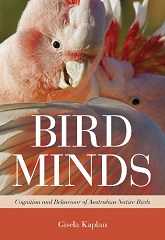
Recent published papers in the field of neurobiology and neuropsychology have dramatically changed our thinking about the avian brain and behavioral potential of birds, especially in the areas of learning, memory, plasticity, and in the cognitive and emotional domains. Bird Minds provides a fresh view of the behavior of Australian native avifauna, presenting a portrait of cognitive well-equipped species, which is somewhat removed from the traditional image of birds as fluttering, colorful ornaments that tend to move like automata.
The book will focus on the specific abilities of Australian birds, examining why they have had to find - largely cognitive - ways of adapting to difficult conditions. The demands of the Australian environment have led to the development of cognitively complex processes that are unique in the world, including complex behaviors such as grieving, deception, problem solving and the use of tools. Many Australian birds cooperate and defend each other, and exceptional ones go fishing by throwing breadcrumbs in the water, extract poisonous parts from prey and use tools to crack open eggshells and mussels.
Chapter 1. Australian conditions and their consequences
Chapter 2. Brain size, long life and resourcefulness
Chapter 3. Foragers, food-switchers and innovators
Chapter 5. Nest and bower builders
Chapter 7. Mimicry and imitation – the cognitive dimensions
Chapter 8. Social and vocal learning
Chapter 9. Emotions, communication and cognition
Chapter 10. Communicating intentionally
Chapter 11. Abstract concepts and states of mind
Chapter 12. Which native birds are smart?
Appendix 1: Behaviour, brain size and life history data of Australian land birds
Appendix 2: Species list of common and Latin names